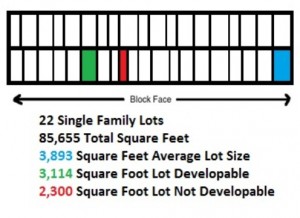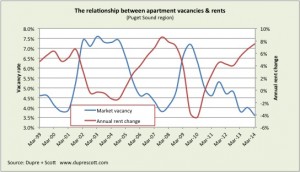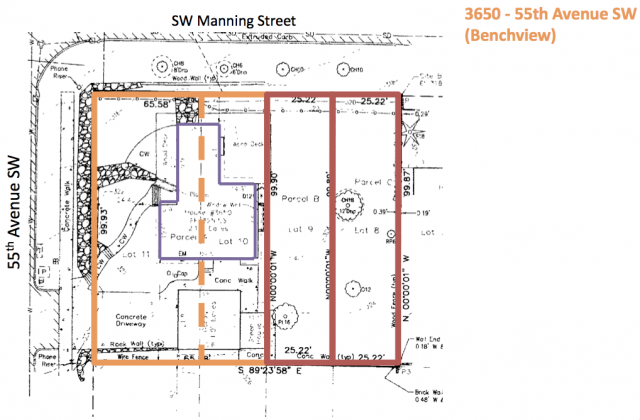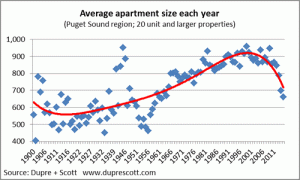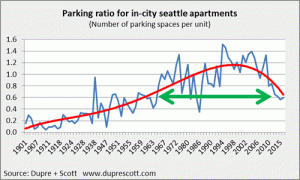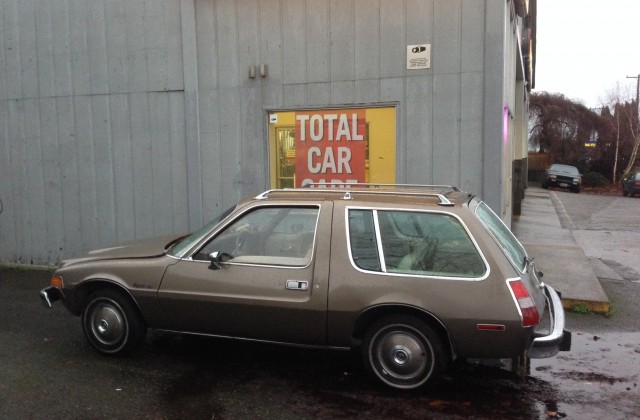DPD Tried to Regulate Small Lots;You Wouldn’t Believe What Happened Next!
Over the last part of the week I kept hearing noises on social media about problems with the Department of Planning and Development’s (DPD) efforts to constrain small-lot development. Here’s the comment that set off the biggest discussions and concerns. According to one homeowner the legislation means that about 8,755 existing homes . . .
. . .won’t be able to add a story. This becomes a big deal as prices continue to rise and people start renting out flats (see: San Francisco). Whatever the intent of this legislation, it becomes a down-zone for those 8,755 houses. It’s worth fighting this.
Publicola and KIRO also followed up on this growing concern, with KIRO airing the story at the top of this post. So what’s going on?
Everything points to the fact that the DPD’s efforts to respond to complaints from a small group of angry neighbors may have inadvertently reduced or eliminated thousands of existing homeowners from fixing up their own property.
This is a pretty big foul up if it’s true with wide impact. Think about it for a moment. A family living in a single-family home decides it wants to add a story to their home to accommodate a new child. Or maybe a family has an older parent who needs to move in for increased care. Suddenly that extra room on another floor isn’t possible. Families often decide to add on to their existing home to save money and avoid the extra expenses and disruption of moving to a new house.
And as if that wasn’t enough here’s what a local architect told me about the new legislation:
I’m rather annoyed at the pile-on of restrictions. It reads like a laundry list of paranoid restrictions put together by people who have never designed housing. I see pretty much nothing in there that reflects the input of the design community.
The problem with what DPD has forwarded is that it creates more burdens for existing homeowners and it doesn’t make anything more predictable for anyone, including angry neighbors. The legislation in its efforts to address neighborhood “concerns” has muddled the code further. The simplest thing to do is to pass what we’ve proposed: the 80 Percent Rule.
The 80 Percent Rule would address angry neighbors by giving them the ability to know exactly what could be built on a block. All they’d have to do is the math, adding up the overall lot sizes and dividing by the number of lots. If they’re worried about height bulk and scale, our proposal has a height limit of 22 feet with setbacks; that ensures a smaller house that the typical 37 height limit in most single-family zones.
Instead of pushing forward a simple solution to the problem it looks like the legislation could make things worse. Is there a way to fix this? There’s one person who can help sort all this out and get us to a solution that will work for everyone: Councilmember Mike O’Brien.
Councilmember O’Brien can help us get closer to where we were at the end of last year, a compromise that created predictability and simplicity so that the city can benefit from more reasonably priced, scaled, and efficient single-family homes. Let him know we need his help. You can e-mail Councilmember O’Brien at Mike.Obrien@Seattle.gov
Good Ideas for Better Housing Choices: Keep Single-Family Infill
I came away from yesterday’s meeting of the Planning, Land Use, and Sustainability (PLUS) Committee with mixed feelings. On the one hand there was a great presentation by Mike Scott of Dupre and Scott which confirmed a number of things for the Committee, not the least of which is that supply and demand really does apply to the housing market.
But I didn’t get positive signals from Committee staff who said that Councilmember O’Brien is leaning toward the recommendations of DPD on small-lot housing. As I pointed out in my comments to the Committee, we made lots of progress toward the end of last year getting closer to a solution for small-lots that would produce greater predictability for neighbors and developers: the 80 Percent Rule. What was on the table then, was adjusting the percentage to 100 or maybe 90 percent with no minimum lot size.
The 80 Percent Rule would allow everyone, builders and neighbors, to know exactly what was a buildable lot on their block by allowing building with setbacks and height limits on lots 80 percent of the average lot on a block.
Instead the DPD proposal takes away more potential infill opportunities by imposing even more arcane rules. One of the best projects in recent memory at Benchview was touted by DPD staff as something that should be stopped instead of seen as a way to preserve existing housing and build new appropriately scaled housing in a single-family neighborhood.
We’ll keep making the case. Ada Healy, Vice President of Vulcan Real Estate had a great opinion piece in the Daily Journal of Commerce that points out exactly what we’re all hoping the Council will keep in mind in the weeks ahead.
We should also adopt policies that encourage more housing supply, choices and opportunities. According to Smart Growth Seattle, a partnership focused on improving Seattle’s land-use code, “Seattle needs policies that make Seattle accessible to people of all incomes by increasing the choices they have. The best way to create more choices for everyone in the city is to allow more housing of all types all over the city.”
Increasing supply includes supporting micro-housing and accessory dwelling units in locations that make sense, making city-owned land available for low-income and workforce housing development, increasing density around transit areas and implementing other innovative tools that would help balance supply and demand.
The challenge of housing affordability is complex and multifaceted, and incentive zoning alone is not the answer — especially in its current form. Seattle deserves housing and land-use policies that provide opportunities for all income ranges by expanding the programs that are working and embracing a wide range of new and innovative options.
Healy is right when it comes to how we should approach housing challenges as we create more jobs and welcome more people into our city: innovation. But is the City Council listening?
Ask Councilmember O’Brien and the Committee to reconsider the 80 Percent Rule as a way to accomplish scaled infill development of new single-family homes on small-lots. Their e-mails are below.
Councilmember Mike O’Brien, Chair
Councilmember Tim Burgess
Councilmember Nick Licata
Small-Lots: Don’t Stop an Innovative Housing Solution
Here are the comments I delivered to the Planning, Land Use, and Sustainability (PLUS) Committee this afternoon. The outcome we are looking for from the Council is legislation that supports more small-lot development that is predictable and scaled to housing already in neighborhoods. The 80 Percent Rule does that.
Comments to PLUS Committee on April 1, 2014
When we originally worked on this issue with former Councilmember Conlin we had reached agreement on the principle that building more single-family homes was an important part of the City’s overall strategy to increase housing options and choices for individuals and families. Small-lot development is an important way to grow our city sustainably.
This proposed legislation does not reflect that principle. Instead what you have in front of you is an effort by the Department of Planning and Development to attenuate housing development in single-family neighborhoods. What we have here is more restrictive interpretation of the code that will make building more housing even more challenging. And then when builders find a way to build more homes, and neighborhoods complain, we’ll be faced with calls for even more restrictions.
The Benchview example is a perfect one. The facts about the Benchview project should matter:
- It’s smaller than it could have been under the code;
- It preserves an existing home on the site;
- It will create a smaller view impact than if the site was fully built out;
- There will be three homes on the site rather than two; and
- The project fits entirely within the “emergency” legislation passed in 2012
Yet this is precisely the kind of innovative building the staff proposal would thwart.
Please consider going back to where we left our discussion with Councilmember Conlin. The 80 Percent Rule we proposed has height limits, setbacks, and would provide predictability for neighborhoods, developers, and DPD staff.
The 80 percent rule would help recover some of the parcels lost to the regulations being considered. The new rule would eliminate the need for Type 2 for small lots. These lots already exist, and notice wouldn’t be an issue because people could know by simply doing the math what lots are buildable and which ones are not. If notice is truly a worry, DPD can send a letter at the time of permit issuance.
Thank you for your consideration.
PLUS Committee: Mike Scott on Multi-family Housing Market
Tucked into today’s busy agenda for the Planning, Land Use, and Sustainability (PLUS) is a presentation from local real estate expert Mike Scott of Dupre and Scott Apartment Advisors. Scott has for years provided data for developers and others trying to figure out trends in multifamily housing in the city. His charts and data are an important window into how the real estate market works. It will be very interesting to see what Scott has to say about how the many decisions Council will making that might impact innovative trends in the housing market.
Here for example is a chart showing apartment size in the city over the last 100 years or so. Scott also mentions this trend in the video I’ve included as well.
Scott points out that apartment sizes have been getting smaller over the last decade especially. Part of this, he suggests, is a trend of going to models from the past to solve problems in todays housing market. Smaller apartments functioned quite well for many people in the 1950s and with demand pressures on the region’s housing supply, smaller units mean an increase in the number of units possible.
Parking is another trend shifting away from more to less.
Part of this is policy decisions by leaders at all levels of government in the region to pull back on parking requirements. Parking is really expensive and adds costs to apartment rents. By not requiring so much of it developers can better respond to the market. As transit has improved in the region, parking is getting less important to people who can find other ways to get around. And it’s a big reason why we need to pass Prop 1 later this month.
But these two things, unit size and less required parking, are often the trends opponents of growth point out as a sign that things are getting worse for people moving to the region not getting better. The truth is that smaller units and fewer parking spots per unit is reflects in large part what people are asking for and what government is allowing by requiring less. This is how sometimes the right intervention by government is to to less intervening and let developers respond to what people are asking for: smaller, less expensive apartments without the added costs of parking.
Ugly Cars: “Backlash and Flight” From Driving?
My last post questioned the idea of adding costs to microhousing projects by running them through the design review process. The reaction was mixed on the social networks. I think some people get the idea that if I show up at your new house and demand that you paint the trim a different color, at your expense, before you move in, that at a minimum you’d be unhappy, but you’d also be stuck with the bill. Someone would have to pay for the improvement to the aesthetics of your new house, even if, as it’s resident, you were fine with the color of the trim.
Here’s one reaction from a Facebook friend and Twitter follower.
I’ve written about this reaction before; it’s a common one among planners, architects, and, now, even City Councilmembers. The argument is that if we build “bad” buildings we’ll somehow turn people against density, cities, and new housing. I think that’s nonsense. What if we applied the same standards to something else people often use and see everyday, often parked all over the neighborhood: cars?
Take a look at this great slide show of ugly cars from over the past 50 years.
Do ugly cars cause “backlash and flight” from driving. Has anyone ever said, “you know, I used to drive but then I saw the El Camino. I was so offended and disgusted I could never drive again.”
Or how about, “one day I turned a corner and saw a Yugo. That changed everything. From that day forward I vowed never to drive or ride in a car again!”
Nope. Same thing is true of housing. There are great buildings and awful buildings. For example, I despise the Seattle Municipal Tower. My days as a City employee were spent in the iconic Arctic Building and going to meetings at the Alaska Building with its nautical themed upper floors (port hole windows!). Why the City ever sold those buildings for the dysfunctional monstrosity of the SMT I’ll never know. But that’s my opinion. And the SMT is working just fine; Department of Planning and Development staff can process fees for design review there just as easily in the historic Dexter Horton building.
And the truth is that microhousing and most new construction isn’t an El Camino or a Yugo. In fact most buildings, by code, have to include many energy efficiency features and other basic requirements that are as strict as fuel efficiency standards for cars. I don’t want to give the Seattle City Council any ideas, but we probably won’t hear mandates for design review for smaller cars like the Smart Car which almost anyone would agree is not an especially attractive car. But it works and it’s efficient and people want it.
Nobody is fleeing the city because of the way buildings look. People are working and living in all kinds of buildings. Why add costs to microhousing and to rents for people who want to live there because someone doesn’t like the way they look? Life in the city goes on, with every kinda buildings, cars, houses and people.
